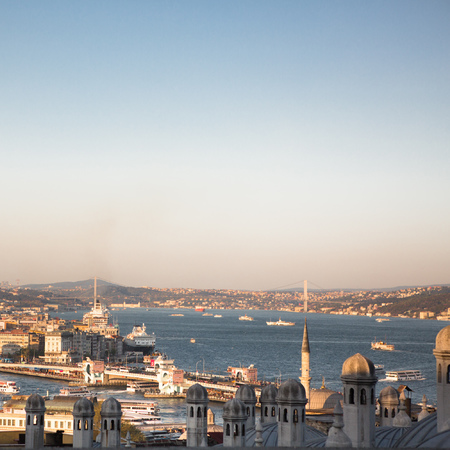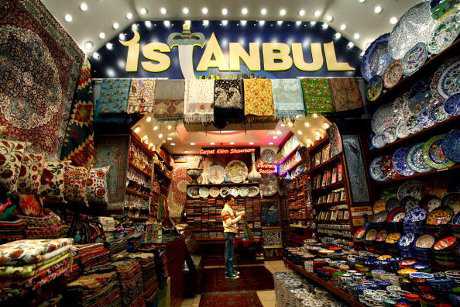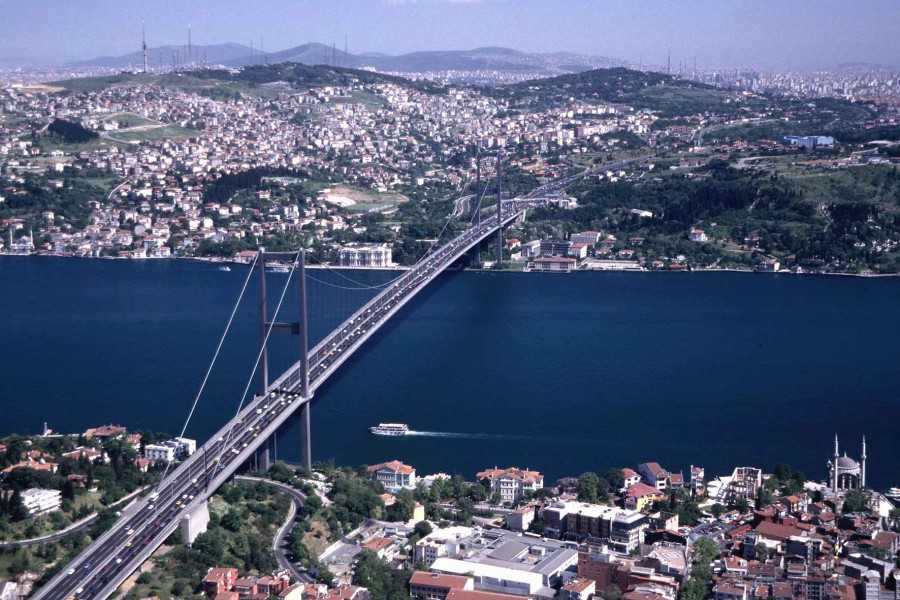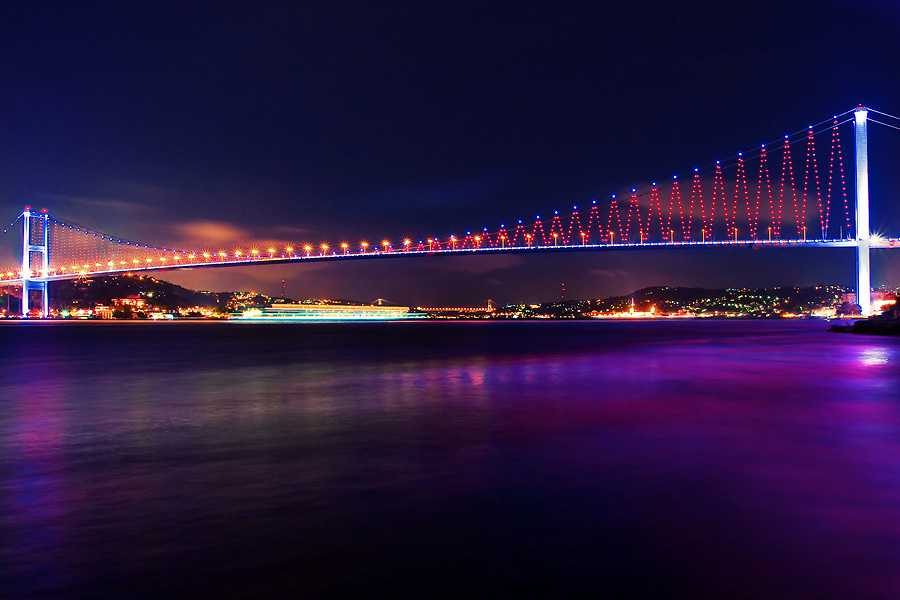Lisa Lubin – November 10th, 2010
An obvious bonus of staying put in one place for a long time is discovering ‘real’Istanbul and its neighborhoods where people live, work, and play. The Lonely Planet guide book goes about as far as Taksim Square—the busy town center, so to speak, of Istanbul.

The colors of the Cihangir Neighborhood.
(photo by Lisa Lubin)
It is here where the broad cobblestone-lined pedestrian drag, Istiklal Caddesi (Independence Street), begins, or ends, depending on which way you are walking. It is flanked on both sides by clothing shops, the ubiquitous Starbucks, kebab and kofte (yummy Turkish meatball) eateries, and bookstores.
Shopping street of Istiklal Caddesi.
(photo by Lisa Lubin)
Beautiful French inspired early twentieth century buildings tower overhead and an old fashioned narrow trolley trundles up the hill for those not wanting to do the popular stroll. And just a ten minute walk down the hill behind Istiklal, toward the Bosphorus Strait, was my neighborhood, Cihangir. It is a former Bohemian enclave now full of expats and artists turned yuppies and hipsters. Nearly everything you need is right there. There is a small produce stand selling plump fresh cherries, apricots, and veggies on every corner. There are grocery stores, bars, cafes, a gym, and an odd plethora of pharmacies. Sounds permeate the air harkening back to an old European village:
“Hot Simit (a kind of Turkish sesame seed ‘bagel’)!! Fresh, hot Simit!!”
“Junkman!! I can take away all your nasty junk!!!”
“Waterman!! I will bring big bottles of spring water right to your apartment!!”
One of my favorite sounds was, strangely enough, the gas man. When I first heard the sweet tunes tinkling out of his truck as he drove around the ‘hood, I thought it had to be an ice cream truck: “Aygaz…get your sweet delicious Aygaz!”
The view from our blogger’s apartment in trendy Cihangir.
(photo by Lisa Lubin)
The third floor apartment I was staying in while I cat sat for “Oscar” and “Wilde,” aka “the OWs,” was far from what I was used to staying in. It had three bedrooms, two bathrooms and huge living room. The back had a balcony overlooking a beautiful stand of tall, leafy trees full of cackling seagulls and feral cats in heat. The one problem? They didn’t seem to believe in screens in Istanbul, so I would say I got moremosquito bites inside that apartment than I had on most of my trip. Unfortunately, because of the summer heat, I had to keep the windows open especially at night while I slept. Well, this was just an open invitation to all the stinging insects to come suck some of my blood. Just as I would drift off to a serene sleep, a high-pitched mosquito buzzing around my hear would jolt be into a total state of itchy ‘awakeness.’ I’d often wake up with new bites on my hands, feet, and even face. The ‘plug-in’ mosquito repellent devices Brigid had did not seem to be working all that much. Some nights I literally had to spray on some repellent just to get more of a sound sleep. There’s nothing like going to bed with the lovely smell of “Off” to give you that camping feeling.
Modern Istanbul at the Kanyon Mall.
(photo by Lisa Lubin)
I lived on a side street right around the corner from several trendy cafes with tables spilling onto the sidewalks in classic European fashion where locals sipped on drinks, tapped away at their laptops (including me), and just about everyone puffed away on a cigarette. The most popular café was Leyla’s, an ultra trendy spot that could be inNew York or London. Café Smyrna’s atmosphere seemed a bit more relaxed, although two nights in a row, paparazzi were staked outside with three television cameras waiting for a shot of a few local celebs. Kahvedan was owned by a gal from San Francisco and was a breezy comfortable place to hang out and have a latte or nice bite of something off their international menu of samosas, pad thai, and ceviche—not the norms in the very homogenized Turkish food scene. I love a good doner (spinning roasted meat) sandwich every now and again, but Turkey isn’t the most ‘international’ as far as cuisine goes, although this is slowly changing. Even though it is speeding along into the twenty-first century like the rest of the world, in many ways, Turkey is still proud of its strong roots and not entirely embracing the Western world. Although it is 99% Muslim, you would never really know this by looking, contrary to popular belief. What I mean by this is the US is about 80% Christian, but you also can’t see this just by looking, at least not in central Istanbul. Here they are Muslim by name, but many I met were not religious or practicing. There is a wrong assumption by many that Turkey is an Arabic country. In fact it is quite the opposite; Turks are fiercely defensive of their secular state which was founded by Mustafa Kemal Ataturk, a general in the Turkish Army from World War I. His Turkish state is based on Western principles of government and is said to be, in theory at least, modern, democratic and provides a definite separation of church and state.
Western Turkey, especially Istanbul, looks like any European city. But what is different is how homogeneously Turkish it is. And by that I mean it is not exactly the melting pot of Chicago, New York, or London. Maybe there are a few Bulgarians, Kurds, and expats sprinkled around, but by and large, Turkey is full of young Turks and they are very proud to be Turkish. Here there is little need for the English language or American products. Turkey has a huge manufacturing sector so they manufacture many of their own goods. In fact, many clothes we wear back in the states are made right here. There are no H&M, Gap, or Banana Republic stores yet (they were rumored to be there the following year), but a lot of their clothes are actually made there cheaply and exported to the states. So, there are some ‘irregulars’ floating around outlets, markets, and the black market.
The “Starbucks” in affluent Bebek overlooking the Strait.
(photo by Lisa Lubin)
In every country I have a habit of checking out the grocery store. In Istanbul’s supermarkets my point is quite evident. Among aisles and aisles of mostly Turkish products the only American names I’d come across were Pepperidge Farm Cookies, Tabasco, Miller Genuine Draft, and Budweiser. I think for some expats that may be all they need. But I have to admit I occasionally have a hankering for some nice comfy, all chemical Kraft Mac and Cheese every now and again.
In my hip ‘hood sushi was just catching on. There were only a few sushi bars around and each savory raw morsel was priced like a rare gem. I desperately needed a sushi fix so I stopped into Tokyo, a slick, contemporary, minimalist Japanese restaurant like any you’d find on nearly every corner in Chicago except there simple maki cost fifteen dollars. That’s a little steep. On the flip side, the drugs there were cheap…and easy to come by. No, not those drugs…prescription drugs. Many pills that we pop in the states can only be had after commandeering a prescription from our “primary care provider” or first getting a referral from our “primary doc” to then go see a specialist who then may give us the prescription we need. In Istanbul for many drugs, no prescription was necessary. Simply walk into any ubiquitous Eczane (drug store) and get what you need…and get it cheap. I acquired a year supply of some pills I needed for $8! At home that would cost me about $100. Hmmm, that gave me a business idea…but probably an illegal one.
A night at the clubs on the Bosphorus Strait.
(photo by Lisa Lubin)
Another cool area of Istanbul not really detailed in the guide book is what’s known as the Bosphorus villages. Along the water, several beautiful and quite affluent neighborhoods overlook the water from expensive apartments, white gleaming trendy cafes, and some glitzy nightclubs. I met a guy from Spain who was living in my neighborhood and working for Nortel. He invited me along to join him and his friends one night at the fancy schmancy Sortie Club. High along the edge of the Bosphorus in an area called Ortakoy are about a dozen swanky outdoor clubs, one after the other, that are pricey, slick and give off an air of elitism with their velvet ropes and beefy security guards blocking the entry. This is the place to see and be seen.
Here you can fork over about $100 a person for some magnificent views, ravioli and a few drinks. It was a bit phony and plastic and reminded me a bit of some of Chicago’s Gold Coast clubs, but there was no denying the gorgeously captivating moonlit views of the water.
The Mighty Bosphorus Bridge.
(photo by Lisa Lubin)
The setting was quite marvelous with white leather couches, dimmed paper lanterns, and the indisputable beauty of the mighty Bosphorus Bridge lit up like a Christmas tree with its own kind of light show, with all its, and the city’s, lights reflecting in the sparkling waters of the strait. So if you take a trip to Istanbul, of course go see the touristy areas and old quarter—it is beautiful, but then be sure to check out some of these ‘off the beaten tourist trail’ spots and see where the real hip Turks are hanging out.
* * *
Lisa Lubin is an Emmy-award-winning television writer/producer/photographer/vagabond. After 15 years in broadcast television she took a sabbatical of sorts, traveling and working her way around the world for nearly three years. You can read her work weekly here at Britannica, and at her own blog,http://www.llworldtour.com/.





